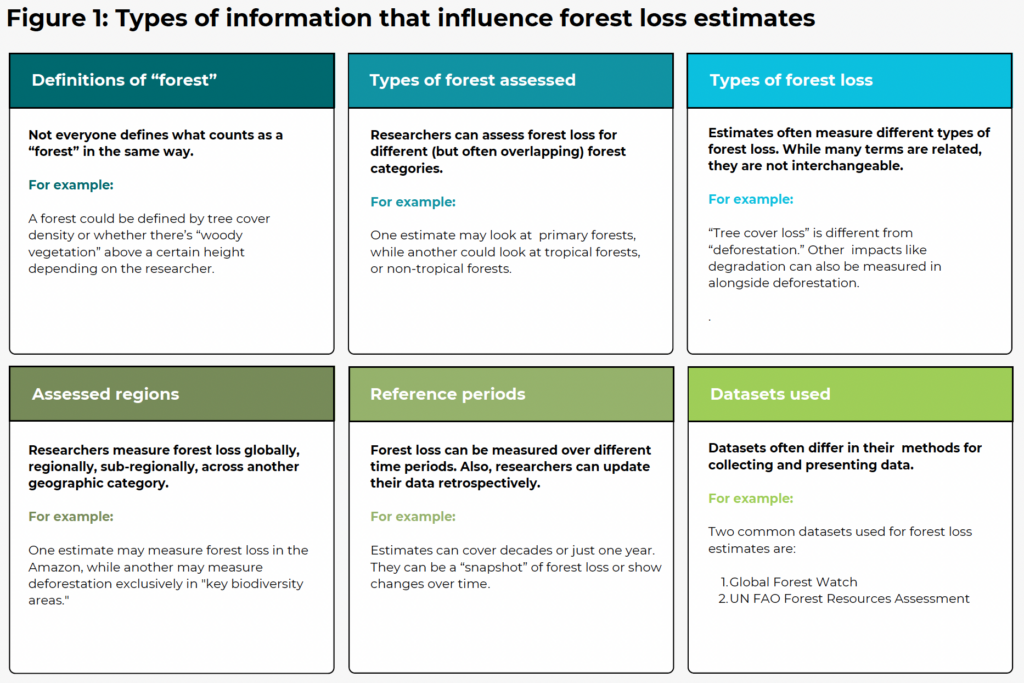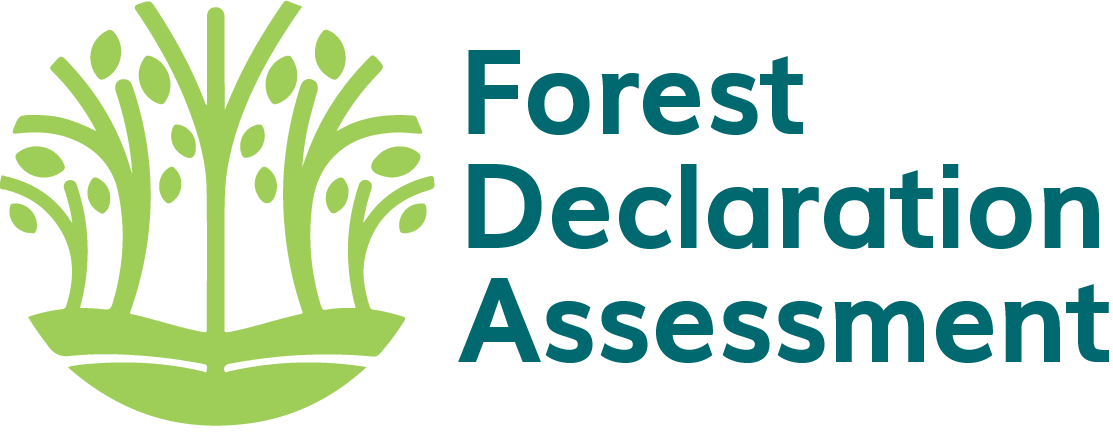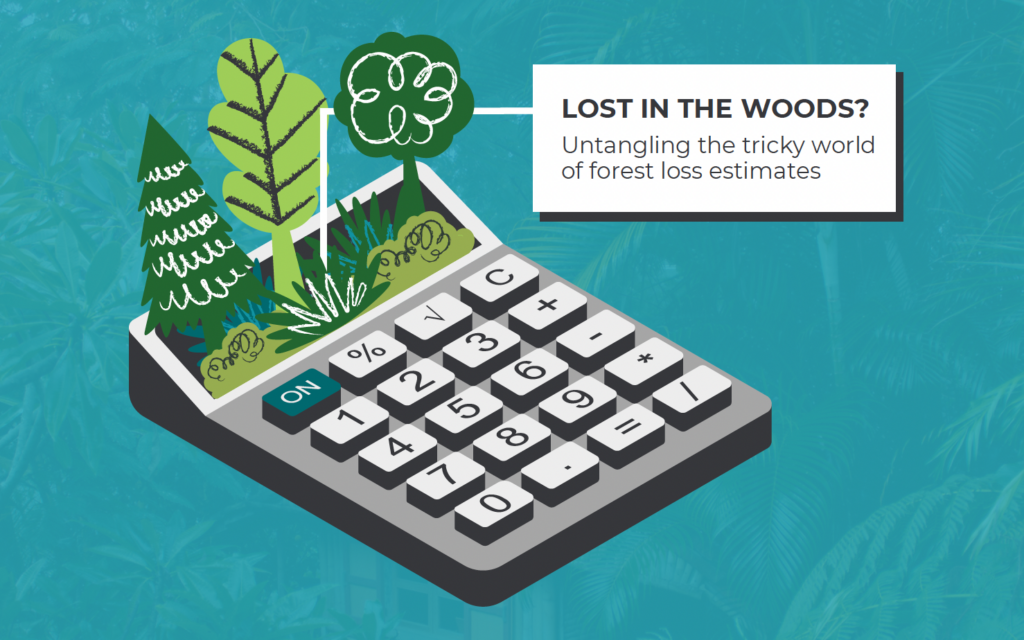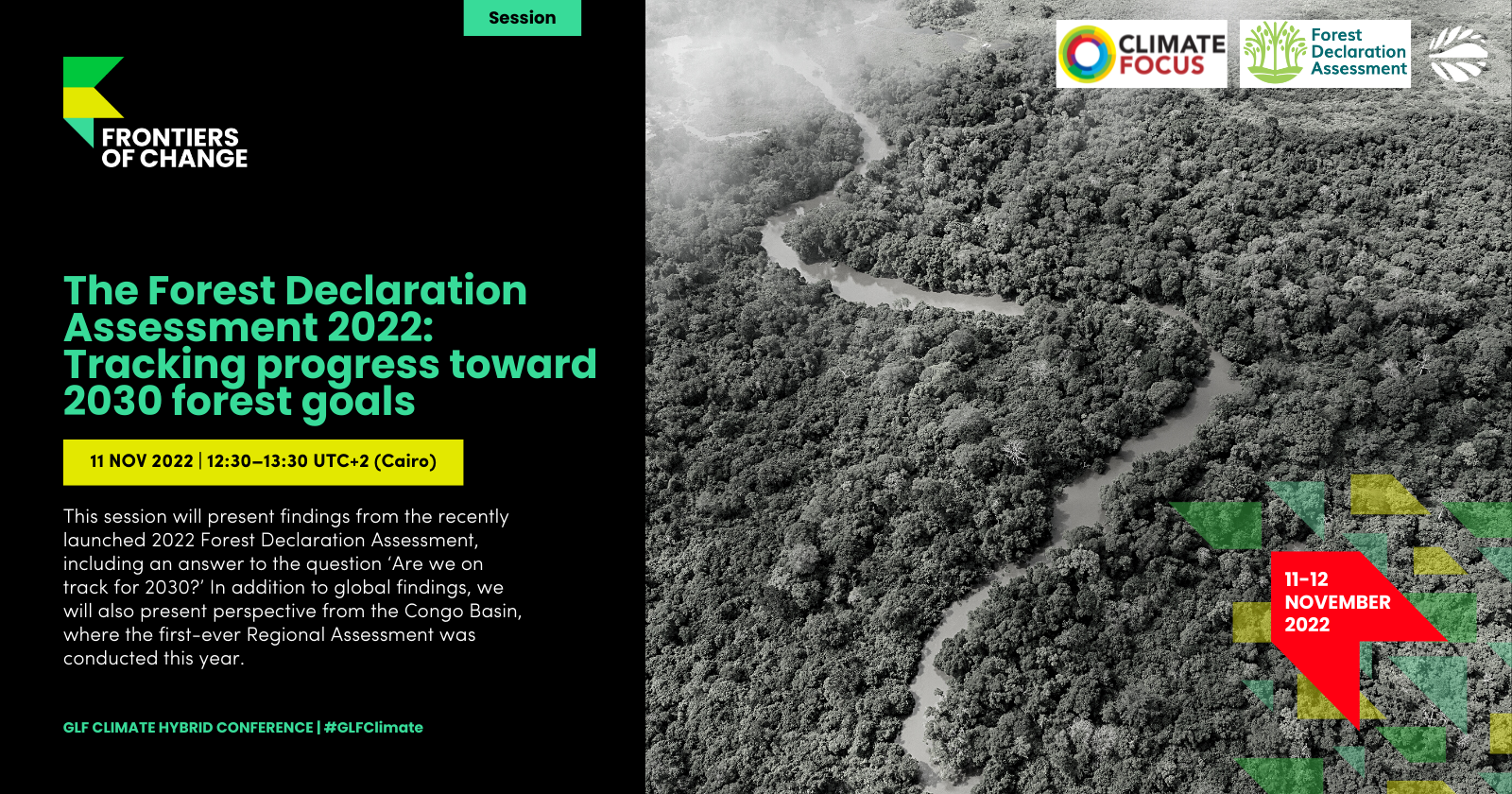How much forest is the world really losing? It's a simple question with a not-so-simple answer.
Our 2022 Forest Declaration Assessment estimated some 6.8 million hectares (Mha) of global gross deforestation in 2021.
Meanwhile, Global Forest Watch (GFW) reported that 11.1 Mha of tropical forest tree cover was lost in 2021.
At first glance, these estimates might seem contradictory – how could there have been more tree cover loss in the tropics alone (11.1 Mha) than there was total global deforestation (6.8 Mha) in a year?
The short answer is that these estimates aren’t truly at odds with one another; they're just measuring different things. As you may have already noticed, the Assessment estimates “deforestation,” which is a narrower category of forest loss compared to GFW's “tree cover loss" estimate, which has a broader definition.
That’s just one example of how forest loss estimates can be tricky to understand if you don’t have the right context. This is especially true with so many forest loss headlines out there from just the last few years of data. And even for experts, these numbers can be complex to untangle.
If you’re still confused, that’s okay – we’ll explain. Let’s look at what information goes into measuring forest loss, which will help uncover why forest loss estimates can seem to differ (quite significantly!) from one another.
Let's begin with a birds-eye view on the many types of information used to estimate forest loss.
Researchers use many different types of information to estimate forest loss (Figure 1). Right off the bat, that helps explain why forest loss estimates sometimes diverge: not all forest loss estimates are measuring the same thing! We explain more about each of these categories below.

Not all researchers and databases define "forest" in the same way.
First, we can all agree on what a “forest” is, right? Not exactly. How “forest” is defined varies across forest loss estimates. For instance, some authors identify forests based on a tree cover density higher than 30%,1 while others define forests as any woody vegetation above 3 meters in height.2 To be clear, neither interpretation is right or wrong (and there are other definitions, too). Still, how researchers define “forest” contributes to the diversity of forest loss estimates out there.
Forest loss estimates often measure different categories of forest loss...
There’s also the difference between “tree cover loss” and “deforestation” to consider (like in the example we mentioned at the start). These two terms are related, but they are not the same thing.
Tree cover loss broadly refers to any decrease in tree cover (that may or may not be permanent). In contrast, deforestation refers to permanent tree cover loss, like a forest deliberately converted to a totally new land use, like agricultural production or urban development. Not everyone defines these terms precisely the same way, either.
...and some of these categories can seem a bit confusing without the right context!
So, deforestation is permanent tree cover loss – simple enough, right? Well, that’s not quite the whole picture.
Even temporary tree cover loss can be considered “deforestation” when the trees being cleared are part of an ancient, intact forest ecosystem (known as a primary forest). This is because it can take hundreds or even thousands of years to re-establish a forest with the same ecological quality as a primary forest. That means that if a primary forest is cut down and replaced by a new, regrowth forest (a secondary forest), that tree cover loss – though it was temporary – is still considered a type of deforestation.
Also, researchers sometimes measure forests against other benchmarks, like forest degradation (when forests lose their ability to provide important ecosystem services) or forest fragmentation (when a forest is broken up by roads or other development, which is a type of degradation), which both interact processes of deforestation. These many different forest indicators add to the diverse landscape of forest estimations. They can be combined with estimates of deforestation or measured on their own.
Of course, you don’t need to memorize these definitions, but hopefully this illustrates the complexities of assessing the state of the world’s forests.
Forest loss is often assessed across different time periods, regions, and using different datasets that vary in their methodologies – so not all estimates are directly comparable.
Next, datasets often measure forest loss over different time periods and regions. Researchers can estimate forest loss on a global, regional, or country level. Estimates sometimes focus in on other geographic scopes, like deforestation in key biodiversity areas (KBAs) – which is upcoming in our 2023 Assessment!
Different researchers might estimate forest loss over decades, for a singular year, or the rate that deforestation is changed compared to a baseline. Sometimes, data are revisited and corrected retroactively; researchers might update their dataset after gaining new knowledge or better data collection methods. This can complicate forest loss estimates that are based on data that was later updated or corrected.
Finally, most estimates of global forest loss draw on data from Global Forest Watch (GFW) or the UN Food and Agriculture Organization’s Forest Resources Assessment (FAO-FRA). Both datasets are important tools and have global coverage, but their methodologies differ. The GFW is an open-source web application to monitor global forests in near real-time and adopts consistent definitions and methodologies across all countries and territories. The data presented by FAO-FRA, on the other hand, are provided by countries that have the right to adopt definitions and methodologies tailored to their respective national contexts.
There are even more nuances and complexities to estimating forest loss, but we’ll stop here. Besides, at this point, you probably get the picture: assessing the state of the world’s forests is completely achievable – but not necessarily simple.
So, how does the Forest Declaration Assessment measure the state of the world’s forests each year?
We are currently producing the 2023 Forest Declaration Assessment, and we’re crunching the numbers so we can provide the most up-to-date data on global forest loss. After all this talk about forest loss estimates, how does the Assessment measure the state of the world’s forests?
We use several quantitative “indicators” (i.e., criteria that can be measured with data) that global forest progress is measured against. These include measures of:
- Gross deforestation
- Humid tropical forest loss
- Emissions from forests
- Forest landscape integrity
- Deforestation within key biodiversity areas
- Carbon stocks and removals
- Forest cover gain
We get data on these indicators from a range of sources, including Global Forest Watch and the Zoological Society of London (both Forest Declaration Assessment Partners). Also, we define our terms (i.e., what we measured, over what regions and time periods, and how we did so), so readers know how we arrived at our estimates.
Besides our reporting on overarching forest goals, the Assessment also publishes three complementary thematic reports on sustainable production and development, finance for forests, and forest rights and governance. These cover private and public sector progress on implement a range of solutions to tackle global forest loss. They also provide recommendations for action, created – as always – through civil society collaboration.
Our findings will be published ahead of COP28, so stay tuned for our updated findings on the state of the world’s forests. But whatever estimate you refer to the meantime, here’s the bottom line:
Global progress on reducing forest loss is not slowing down fast enough to reach the 2030 goals of halting and reversing deforestation. The world needs to step up – and do so quickly – to protect forests and all they provide for us.
- Hansen, M. C., Potapov, P. V., Moore, R., Hancher, M., Turubanova, S. A., Tyukavina, A., et al. (2013). High-Resolution Global Maps of 21st-Century Forest Cover Change. Science, 342(6160), 850–853.
- Potapov, P., Hansen, M. C., Pickens, A., Hernandez-Serna, A., Tyukavina, A., Turubanova, S., et al. (2022). The Global 2000-2020 Land Cover and Land Use Change Dataset Derived From the Landsat Archive: First Results. Frontiers in Remote Sensing, 3. https://www.frontiersin.org/articles/10.3389/frsen.2022.856903.






